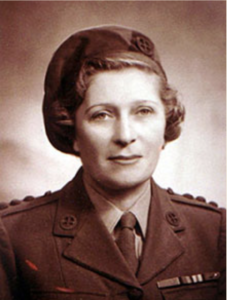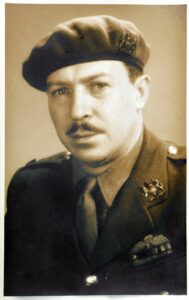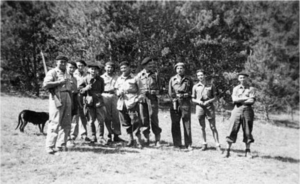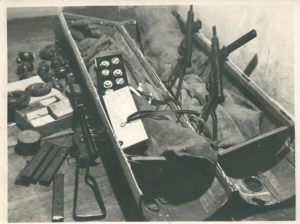
The Fighter From the Tiny Island
The tiny African island of Mauritius is only slightly bigger than the City of London, and much less densely packed – slightly more than 1.2 million people versus London’s nearly 9 million.
The island punched above its weight in providing heroic agents for the Allied Cause in World War II, however. One of those agents was a woman named Lise de Baissac.

Due to the colonial history of Mauritius, although it was a British possession during World War II, the inhabitants often spoke French as their first language. Lise and her family were no exception. The family were in Paris when Germany invaded in 1940, and Lise and her brother Claude managed to escape to Britain by way of Gibraltar. Claude immediately joined the fledgling Special Operations Executive (SOE) being organized to commit espionage, sabotage, and gather intelligence behind Axis lines, but Lise had to wait longer until women were accepted into the ranks. She bided her time working as a journalist, and as soon as the opportunity presented itself she interviewed and headed off to her training in May 1942.

“In my view, women were very much better than men for the work. Women have a far greater capacity for cool and lonely courage than men,” Sir Selwyn Jepson, SOE Senior Recruiting Officer
On the night of 24/25 September 1942, Lise was one of the first women to parachute into occupied France, where she set up a one-woman network named ARTIST. Using the cover story of a poor widow from Paris who was looking for relief from the chronic food shortages in Paris, she managed to find an apartment just near the Gestapo headquarters in Poitiers, where she often exchanged morning pleasantries with Herr Grabowski, the Gestapo chief.
While Lise was in France, she managed to meet and brief 13 new SOE agents inserted by the allies, as well as organizing departures, collecting weapons drops, and relaying information to other networks. She often liaised with her brother’s Paris Network codenamed SCIENTIST.
Lise would make brief contact as necessary with other SOE agents, but outside of necessary interactions she avoided the others in her profession, and that may have been the key to how she survived for nearly 11 months on her first insertion into the field. It was an impressive length of time, when the average SOE wire operator dropped behind enemy lines only lasted six weeks before being killed or captured.
Lise would explain her movements throughout the French countryside as a part of her interests as an amateur archaeologist.
By June of 1943, both Lise’s network ARTIST and her brother’s network SCIENTIST had been infiltrated by the Gestapo, and it was time to leave France before being captured. Captured agents could expect to be tortured and sent to concentration camps before being killed. In at least one instance, female SOE agents at Ravensbruck were known to have been sent to the crematorium while still alive.
The Allied governments worked to get agents out before capture, but it was often impossible. In the case of Lise de Baissac and her brother Claude, the attempt was a success. On the night of 16/17 August the two were transported back to Britain, although not without controversy. It seems that when Claude’s SCIENTIST group was infiltrated and he was given the option to leave, he chose to bring his sister rather than one of the other SCIENTIST agents he had been working with – Mary Herbert, who was pregnant with Claude’s child.

Lise did not return to a calm life in Britain, instead she prepared for another mission. Delayed to let a broken leg heal, she was re-inserted into France on 9/10 April 1944 into the PIMIENTO network under the code name Marguerite. Her upper-class mannerisms were not a good fit for the group of trade unionists and manual laborers, and so by mutual agreement the she parted ways and joined her brother Claude, this time in southern Normandy. Leading up to the Allied invasion of Normandy, she worked as a bike courier and as a liaison with the French Maquis, who knew that an allied invasion was in the works, but were having a hard time waiting for the signal to begin intensive disruptive efforts.

That signal came via a British code phrase over the radio on 5 June 1944 while Lise was in Paris. She departed immediately and managed to bike 300 kilometers over the next three days, passing German troop concentrations and sleeping in ditches, until she was in place.
At night she would gather weapons from allied drops and distribute them to resistance troops, and she would also set booby traps along the roads. During the day she repositioned wireless operators to keep them from being discovered by the Germans.

In one incident she, along with a group of the Maquis to whom she had delivered weapons, were caught in a firefight with German troops. She was credited with killing several of the enemy.
Her second mission behind enemy lines in France came to a finish on 13 August 1944, when American troops reached her area of operations. She met them wearing her training uniform of the First Aid Nursing Yeomanry, which she had kept carefully hidden through the entire war. Lise was again returned to Britain.
She would return to France one final time as an agent of the SOE – in September 1944 as a part of the JUDEX mission, assigned to locate lost and captured SOE agents. Her personal objective was to locate Mary Herbert, the woman her brother had left behind in 1943.
Mary had given birth to a daughter named Claudine in December 1943. Captured by the Gestapo in early 1944, Claudine was taken to an orphanage. Mary managed to talk her way out of confinement, locate Claudine, and move to a rural farmhouse, where Lise and Claude eventually found her.
Mary and Claude did return to Britain and were married, but the marriage was not successful.
Lise de Baissac’s war was now over; she had been one of the survivors in a band of sisters with a mortality rate of nearly 50%.
After the war she worked for the BBC and married the man she had fallen in love with as a teenager. She died in France on 29 March 2004, just short of her 100th birthday.
This is no war of chieftains or of princes, of dynasties or national ambition; it is a war of peoples and of causes. There are vast numbers, not only in this island but in every land, who will render faithful service in this war but whose names will never be known, whose deeds will never be recorded. This is a war of the Unknown Warriors; but let all strive without failing in faith or in duty, and the dark curse of Hitler will be lifted from our age. –Winston Churchill
- May 12, 2021
- History
